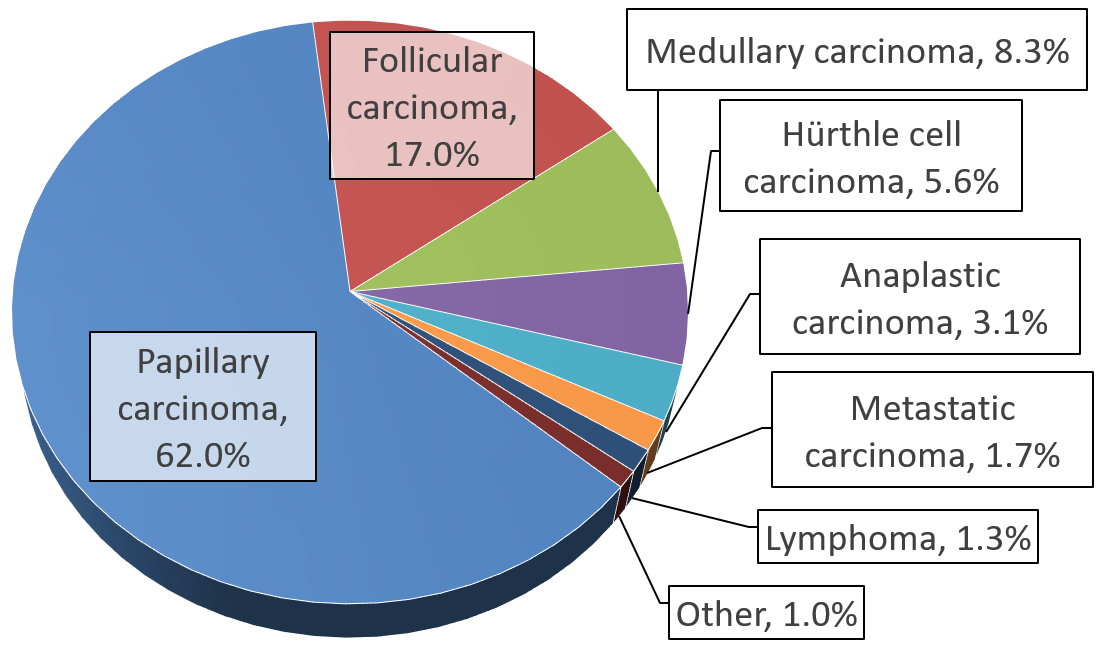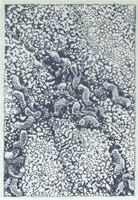|
Thyroid Lymphoma
Thyroid lymphoma is a rare cancer constituting 1% to 2% of all thyroid cancers and less than 2% of lymphomas. Thyroid lymphomas are classified as non–Hodgkin's B-cell lymphomas in a majority of cases, although Hodgkin's lymphoma of the thyroid has also been identified. Signs and symptoms As with other thyroid lesions, thyroid lymphoma affects predominantly females over 70 years of age with a history of Hashimoto's thyroiditis. Thus, Hashimoto's thyroiditis is considered a risk factor for thyroid lymphoma development. Thyroid lymphoma manifests as a rapidly enlarging neck mass which may compress the nearby trachea thereby causing narrowing or obstruction of the airway resulting in breathing difficulties or even respiratory failure. On physical examination, affected people typically exhibit a firm thyroid gland and enlarged lymph nodes. * Painless neck mass * Hoarseness * Difficulty swallowing * Signs of tracheal compression Diagnosis Thyroid lymphoma poses a diagnostic and thera ... [...More Info...] [...Related Items...] OR: [Wikipedia] [Google] [Baidu] |
ENT Surgery
Otorhinolaryngology ( , abbreviated ORL and also known as otolaryngology, otolaryngology–head and neck surgery (ORL–H&N or OHNS), or ear, nose, and throat (ENT)) is a surgical subspecialty within medicine that deals with the surgical and medical management of conditions of the head and neck. Doctors who specialize in this area are called otorhinolaryngologists, otolaryngologists, head and neck surgeons, or ENT surgeons or physicians. Patients seek treatment from an otorhinolaryngologist for diseases of the ear, Human nose, nose, throat, base of skull, base of the skull, head, and neck. These commonly include functional diseases that affect the senses and activities of eating, drinking, speaking, breathing, swallowing, and hearing. In addition, ENT surgery encompasses the surgical management of cancers and benign tumors and reconstruction of the head and neck as well as plastic surgery of the face, scalp, and neck. Etymology The term is a combination of Neo-Latin classic ... [...More Info...] [...Related Items...] OR: [Wikipedia] [Google] [Baidu] |
Dysphagia
Dysphagia is difficulty in swallowing. Although classified under " symptoms and signs" in ICD-10, in some contexts it is classified as a condition in its own right. It may be a sensation that suggests difficulty in the passage of solids or liquids from the mouth to the stomach, a lack of pharyngeal sensation or various other inadequacies of the swallowing mechanism. Dysphagia is distinguished from other symptoms including odynophagia, which is defined as painful swallowing, and globus, which is the sensation of a lump in the throat. A person can have dysphagia without odynophagia (dysfunction without pain), odynophagia without dysphagia (pain without dysfunction) or both together. A psychogenic dysphagia is known as phagophobia. Classification Dysphagia is classified into the following major types: # Oropharyngeal dysphagia # Esophageal and obstructive dysphagia # Neuromuscular symptom complexes # Functional dysphagia is defined in some patients as having no organic c ... [...More Info...] [...Related Items...] OR: [Wikipedia] [Google] [Baidu] |
Thyroid Cancer
Thyroid cancer is cancer that develops from the tissues of the thyroid gland. It is a disease in which cells grow abnormally and have the potential to spread to other parts of the body. Symptoms can include swelling or a lump in the neck, difficulty swallowing or voice changes including hoarseness, or a feeling of something being in the throat due to mass effect from the tumor. However, most cases are asymptomatic. Cancer can also occur in the thyroid after spread from other locations, in which case it is not classified as thyroid cancer. Risk factors include radiation exposure at a young age, having an enlarged thyroid, family history and obesity Obesity is a medical condition, considered by multiple organizations to be a disease, in which excess Adipose tissue, body fat has accumulated to such an extent that it can potentially have negative effects on health. People are classifi .... The four main types are papillary thyroid cancer, follicular thyroid canc ... [...More Info...] [...Related Items...] OR: [Wikipedia] [Google] [Baidu] |
Mediastinum
The mediastinum (from ;: mediastina) is the central compartment of the thoracic cavity. Surrounded by loose connective tissue, it is a region that contains vital organs and structures within the thorax, mainly the heart and its vessels, the esophagus, the trachea, the vagus nerve, vagus, phrenic nerve, phrenic and cardiac nerves, the thoracic duct, the thymus and the lymph nodes of the central chest. Anatomy The mediastinum lies within the thorax and is enclosed on the right and left by pulmonary pleurae, pleurae. It is surrounded by the chest wall in front, the lungs to the sides and the Spine (anatomy), spine at the back. It extends from the sternum in front to the vertebral column behind. It contains all the organs of the thorax except the lungs. It is continuous with the loose connective tissue of the neck. The mediastinum can be divided into an upper (or superior) and lower (or inferior) part: * The superior mediastinum starts at the superior thoracic aperture and ends ... [...More Info...] [...Related Items...] OR: [Wikipedia] [Google] [Baidu] |
Prednisone
Prednisone is a glucocorticoid medication mostly used to immunosuppressive drug, suppress the immune system and decrease inflammation in conditions such as asthma, COPD, and rheumatologic diseases. It is also used to treat high blood calcium due to cancer and adrenal insufficiency along with other steroids. It is taken Oral administration, by mouth. Common side effects may include cataracts, Osteoporosis, bone loss, easy bruising, muscle weakness, and oral candidiasis, thrush. Other side effects include weight gain, swelling, high blood sugar, increased risk of infection, and psychosis. It is generally considered safe in pregnancy and low doses appear to be safe while the user is breastfeeding. After prolonged use, prednisone must be stopped gradually. Prednisone is a prodrug and must be converted to prednisolone by the liver before it becomes active. Prednisolone then binds to glucocorticoid receptors, activating them and triggering changes in gene expression. Prednison ... [...More Info...] [...Related Items...] OR: [Wikipedia] [Google] [Baidu] |
Vincristine
Vincristine, also known as leurocristine and sold under the brand name Oncovin among others, is a chemotherapy medication used to treat a number of types of cancer. This includes acute lymphocytic leukemia, acute myeloid leukemia, Hodgkin lymphoma, neuroblastoma, and small cell lung cancer among others. It is given intravenously. Most people experience some side effects from vincristine treatment. Commonly it causes a change in sensation, hair loss, constipation, difficulty walking, and headaches. Serious side effects may include neuropathic pain, lung damage, or leukopenia, low white blood cells which increases the risk of infection. Use during pregnancy may result in birth defects. It works by mitotic inhibitor, stopping cells from dividing properly. It is vital that it not be given intrathecal administration, intrathecally, as this may kill. Vincristine was first isolated in 1961. It is on the WHO Model List of Essential Medicines, World Health Organization's List of Ess ... [...More Info...] [...Related Items...] OR: [Wikipedia] [Google] [Baidu] |
Doxorubicin
Doxorubicin, sold under the brand name Adriamycin among others, is a chemotherapy medication used to treat cancer. This includes breast cancer, bladder cancer, Kaposi's sarcoma, lymphoma, and acute lymphocytic leukemia. It is often used together with other chemotherapy agents. Doxorubicin is given by injection into a vein. Common side effects include hair loss, bone marrow suppression, vomiting, rash, and inflammation of the mouth. Other serious side effects may include allergic reactions such as anaphylaxis, heart damage, tissue damage at the site of injection, radiation recall, and treatment-related leukemia. People often experience red discoloration of the urine for a few days. Doxorubicin is in the anthracycline and antitumor antibiotic family of medications. It works in part by interfering with the function of DNA. Doxorubicin was approved for medical use in the United States in 1974. It is on the World Health Organization's List of Essential Medicines. Version ... [...More Info...] [...Related Items...] OR: [Wikipedia] [Google] [Baidu] |
Cyclophosphamide
Cyclophosphamide (CP), also known as cytophosphane among other names, is a medication used as chemotherapy and to suppress the immune system. As chemotherapy it is used to treat lymphoma, multiple myeloma, leukemia, ovarian cancer, breast cancer, small cell lung cancer, neuroblastoma, and sarcoma. As an immune suppressor it is used in nephrotic syndrome, ANCA-associated vasculitis, and following organ transplant, among other conditions. It is taken by mouth or injection into a vein. Most people develop side effects. Common side effects include low white blood cell counts, loss of appetite, vomiting, hair loss, and bleeding from the bladder. Other severe side effects include an increased future risk of cancer, infertility, allergic reactions, and pulmonary fibrosis. Cyclophosphamide is in the alkylating agent and nitrogen mustard family of medications. It is believed to work by interfering with the duplication of DNA and the creation of RNA. Cyclophosphamide was approved ... [...More Info...] [...Related Items...] OR: [Wikipedia] [Google] [Baidu] |
MALT
Malt is any cereal grain that has been made to germinate by soaking in water and then stopped from germinating further by drying with hot air, a process known as "malting". Malted grain is used to make beer, whisky, malted milk, malt vinegar, confections such as Maltesers and Whoppers, flavored drinks such as Horlicks, Ovaltine, and Milo (drink), Milo, and some baked goods, such as malt loaf, bagels, and Rich Tea biscuits. Malted grain that has been ground into a coarse meal is known as "sweet meal". Malting grain develops the enzymes (α-amylase, β-amylase) required for modifying the grains' starches into various types of sugar, including monosaccharide glucose, disaccharide maltose, trisaccharide maltotriose, and higher sugars called maltodextrines. It also develops other enzymes, such as proteases, that break down the proteins in the grain into forms that can be used by yeast. The point at which the malting process is stopped affects the starch-to-enzyme ratio, and partly ... [...More Info...] [...Related Items...] OR: [Wikipedia] [Google] [Baidu] |
Marginal Zone B-cell Lymphoma
Marginal zone lymphomas, also known as marginal zone B-cell lymphomas (MZLs), are a heterogeneous group of lymphomas that derive from the malignant transformation of marginal zone B-cells. Marginal zone B cells are innate lymphoid cells that normally function by rapidly mounting IgM antibody immune responses to antigens such as those presented by infectious agents and damaged tissues. They are lymphocytes of the B-cell line that originate and mature in secondary lymphoid follicles and then move to the marginal zones of mucosa-associated lymphoid tissue (MALT), the spleen, or lymph nodes. Mucosa-associated lymphoid tissue is a diffuse system of small concentrations of lymphoid tissue found in various submucosal membrane sites of the body such as the gastrointestinal tract, mouth, nasal cavity, pharynx, thyroid gland, breast, lung, salivary glands, eye, skin and the human spleen. In 2016, the World Health Organization classified MZLs into three different types. Extranodal margina ... [...More Info...] [...Related Items...] OR: [Wikipedia] [Google] [Baidu] |
Fine-needle Aspiration
Fine-needle aspiration (FNA) is a diagnostic procedure used to investigate lumps or masses. In this technique, a thin (23–25 gauge (0.52 to 0.64 mm outer diameter)), hollow needle is inserted into the mass for sampling of cells that, after being stained, are examined under a microscope (biopsy). The sampling and biopsy considered together are called fine-needle aspiration biopsy (FNAB) or fine-needle aspiration cytology (FNAC) (the latter to emphasize that any aspiration biopsy involves cytopathology, not histopathology). Fine-needle aspiration biopsies are very safe for minor surgical procedures. Often, a major surgical (excisional or open) biopsy can be avoided by performing a needle aspiration biopsy instead, eliminating the need for hospitalization. In 1981, the first fine-needle aspiration biopsy in the United States was done at Maimonides Medical Center. The modern procedure is widely used to diagnose cancer and inflammatory conditions. Fine needle aspiration is g ... [...More Info...] [...Related Items...] OR: [Wikipedia] [Google] [Baidu] |
Anaplastic Thyroid Cancer
Anaplastic thyroid cancer (ATC), also known as anaplastic thyroid carcinoma, is an aggressive form of thyroid cancer characterized by uncontrolled growth of cells in the thyroid gland. This form of cancer generally carries a very poor prognosis due to its aggressive behavior and resistance to cancer treatments. The cells of anaplastic thyroid cancer are highly abnormal and usually Anaplasia, no longer resemble the original thyroid cells and have poor cellular differentiation, differentiation. ATC is an uncommon form of thyroid cancer only accounting for 1-2% of cases, but due to its high mortality, is responsible for 20-50% of deaths from thyroid cancer. The Survival rate#Median survival, median survival time after diagnosis is three to six months. Some studies report that 10% to 15% survive more than 1 year; 3-year and 5-year survival is very rare. It occurs more commonly in women than in men and is seen most commonly in people ages 40 to 70. Signs and symptoms Anaplastic thy ... [...More Info...] [...Related Items...] OR: [Wikipedia] [Google] [Baidu] |







